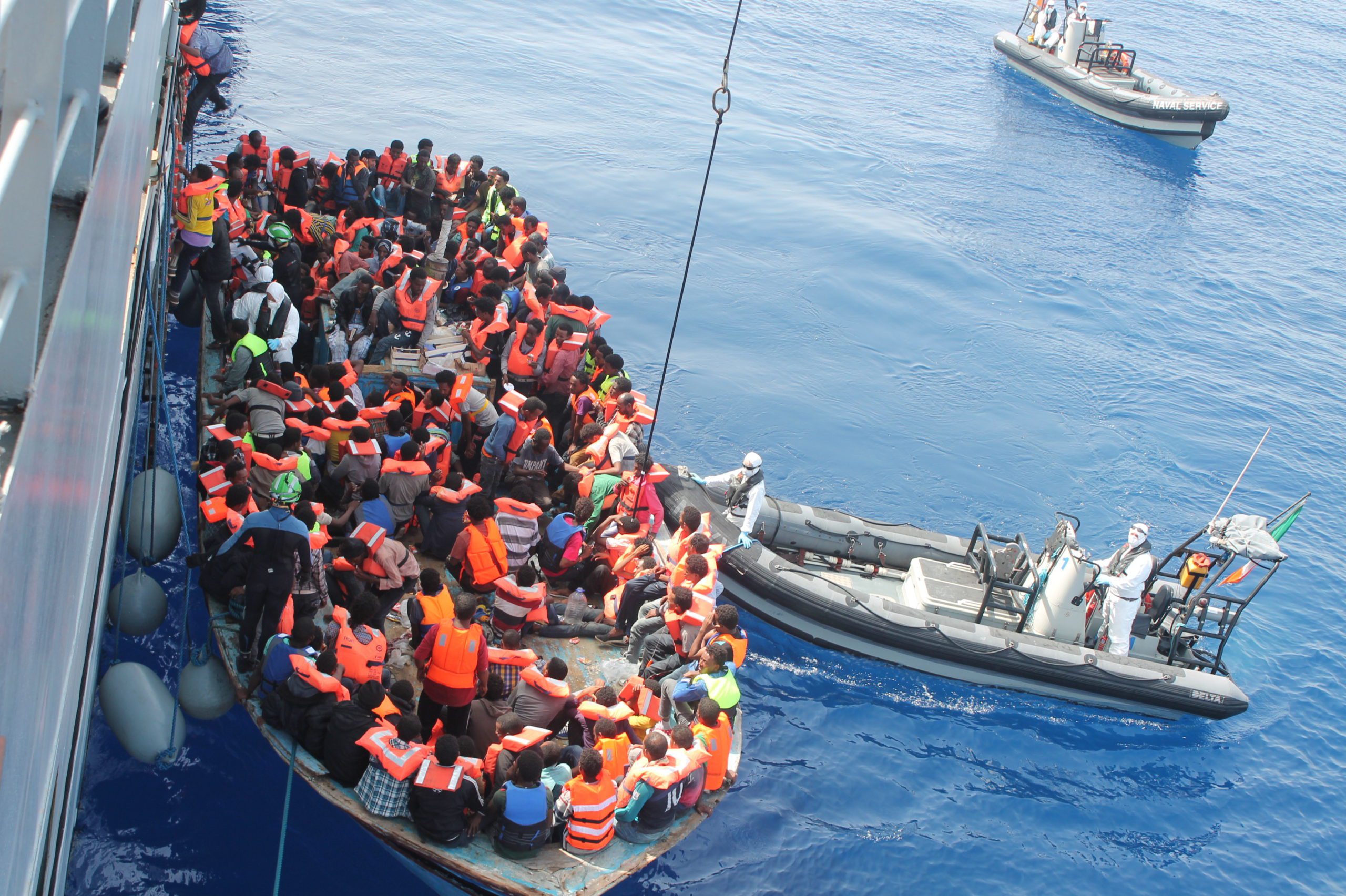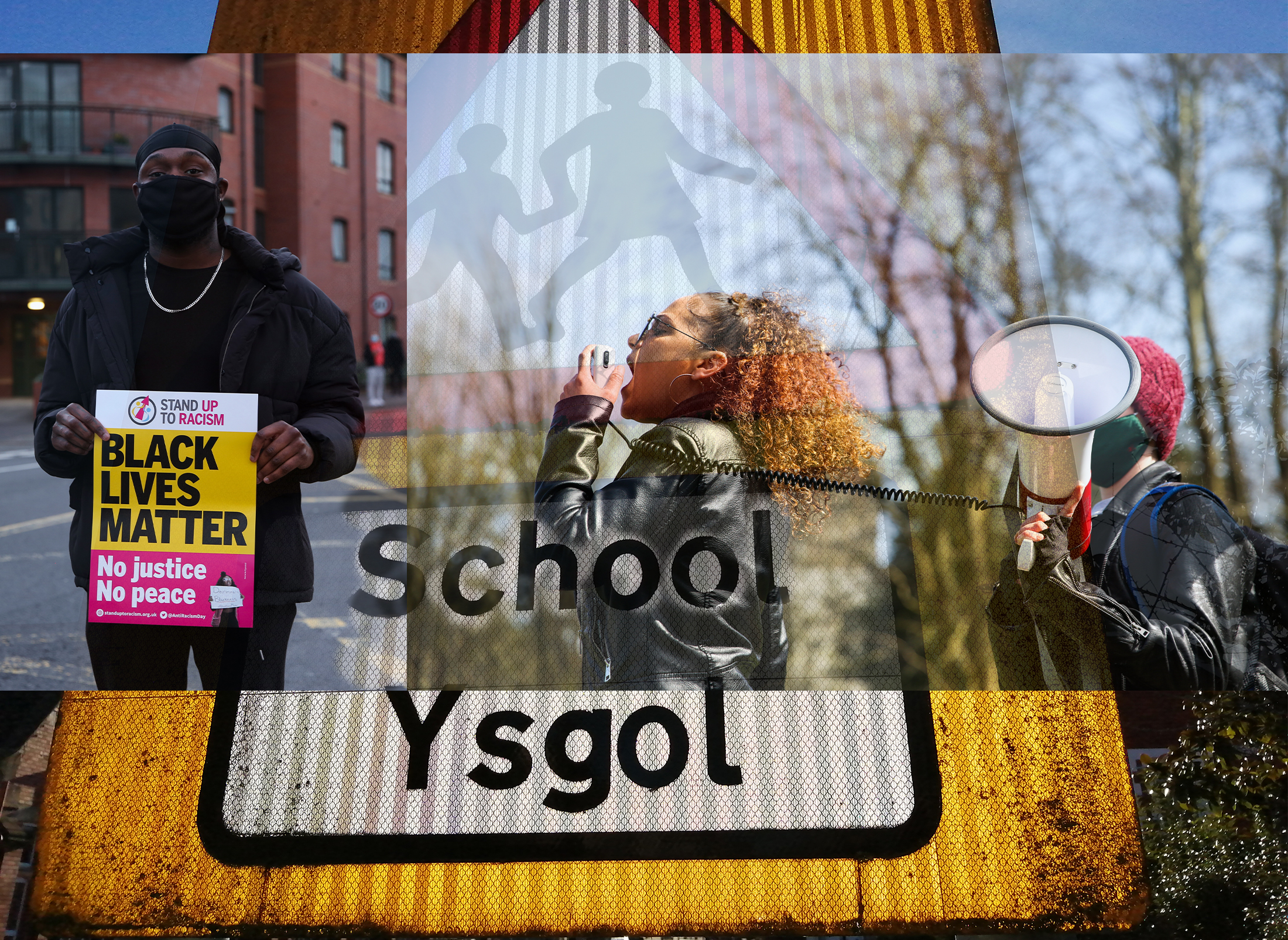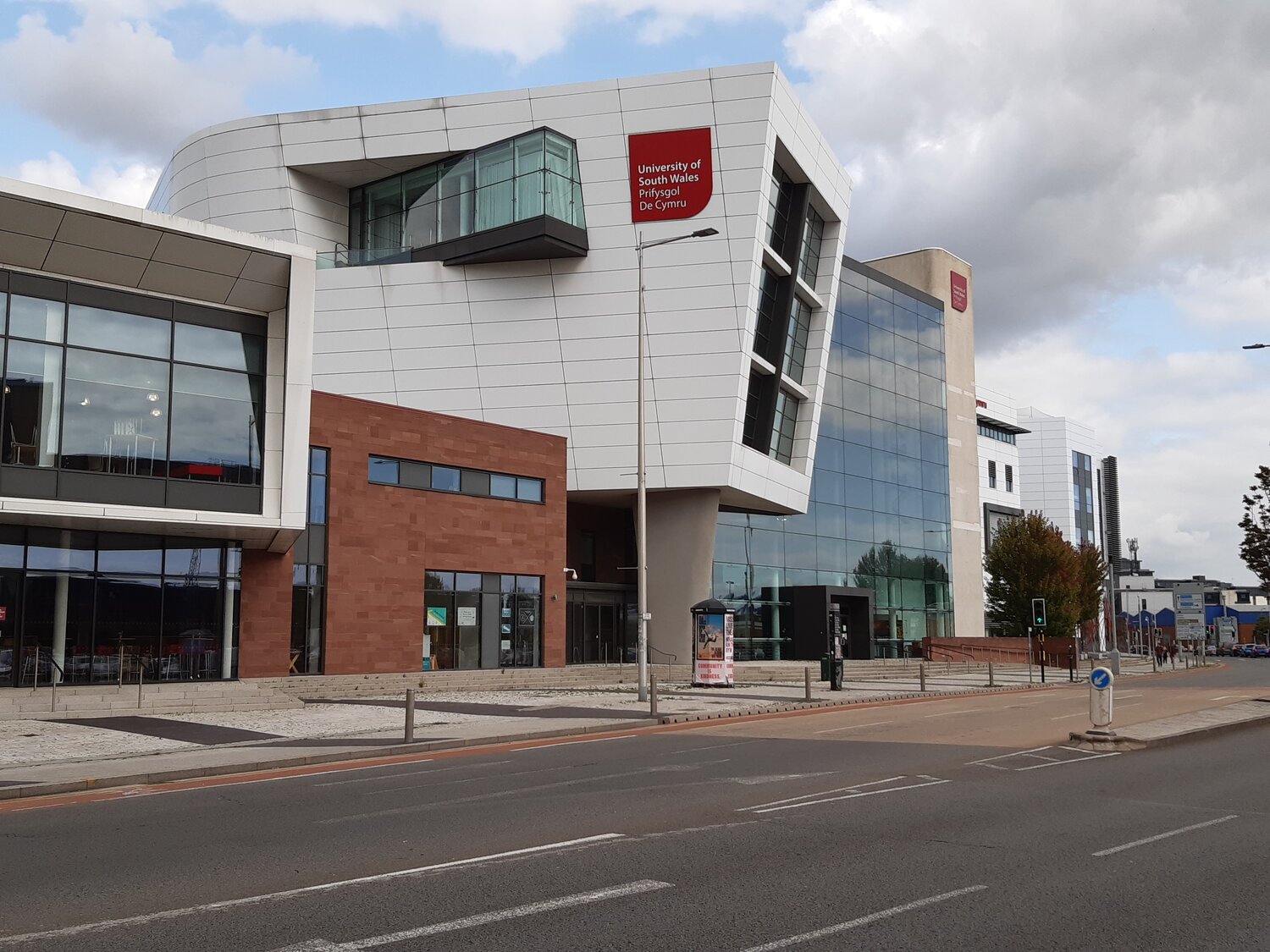
27 Deaths, 27 Lives: UK & EU Governments Have Blood On Their Hands
With the tragic deaths of 27 people as they attempted to cross the channel to the UK, and the volatile situation at the Belarusian-Polish border, where refugees have been attacked by tear gas and water cannons, voice.wales explores recent events, and the hostile environment responsible for them.
Image: Irish Naval personnel rescuing migrants during the 2015 refugee crisis, via Creative Commons.
On Wednesday, 27 people who were headed for the UK drowned near Calais after their boat – which has been likened to an inflatable swimming pool in its quality – sank.
So far only one of the boat’s passengers has been identified: Maryam Nuri Mohamed Amin, a 24-year-old Kurdish woman from northern Iraq. As the dinghy sank, she messaged her fiancé who lives in the UK, attempting to reassure him that they would be rescued.
Others are still being identified, but so far we know that among them were 17 men, seven women – one of whom was pregnant – and three children. Each and every one of them had a name, a family, and a story, though media reports will reduce them to ‘migrants’.
As expected, home secretary Priti Patel has shifted the focus to people smugglers and the need for “more officers on the ground”, an attempt to absolve herself and her colleagues – who have waged a war against refugees and asylum seekers since coming into office – of any guilt.
Just the day before the tragedy, BBC Newsnight’s Lewis Goodall reported that “scores and scores of people” were walking along the roadside not far from Calais after their camp “was broken up by police”, with their sleeping bags and equipment confiscated.
This is the reality of the daily harassment faced by asylum seekers in France, a country where the centrist President Emmanual Macron was hailed as a liberal bulwark against the racism of the far right just a few years ago.
But instead the actions of Macron, who faces re-election next year, is only putting into practice the ‘zero tolerance’ demands of the far right and building their support in the process.
To understand the rise of the far right and fascism in Europe, we only have to look at the barbaric treatment of an overwhelmingly Black and Brown asylum seeker population by the EU. The consequences for those unlucky enough to fall victim to this system are dire.
In the same Twitter thread the next day, Goodall reported that the French coast guard had “issued a mayday for 15 people who have been tipped into the water”, and that one aid agency warned the channel risked becoming “a graveyard”. This was proven to be true just hours later.
The distance between Calais and Dover is little more than 20 miles, but the journey is perilous, and the International Organisation for Migration (IOM) says about 200 people have died while making the journey so far this year. Even after Wednesday’s tragedy, desperate people are still attempting the crossing as bad weather is forecast for the weekend, which could make their journey increasingly dangerous or prevent it altogether.
Priti Patel has labeled the Channel crossings “unnecessary” and “illegal”. However, some opposition MPs, charities and activists have pointed out that there is no legal route into the UK. As one organisation points out: “To claim asylum in Europe, refugees have to get here first. To travel by ordinary lawful routes, these people are required to obtain visas. And there are no visas available for those who are seeking asylum.”
Patel will argue that those seeking asylum should apply in the first safe country they enter, but many people attempt to come to the UK from other EU countries because they speak English or have other family members here already, or simply believe it is the best place for them to come to. And as one asylum seeker in France told the BBC this week after all their possessions had been taken by French police, the country is hardly a ‘safe haven.’
Asylum seekers must be physically in the UK in order to start the claim process, which is supposed to take six months, though many wait longer. But reaching the UK is only half of the battle: asylum seekers in the UK face a range of obstacles, including low quality housing, not being allowed to work, and a cash allowance of just £39.63 a week. Contrary to public perception, the UK receives about a third of the asylum applications which France gets, and 1% of the 4,000,000 refugees in Turkey.
According to those involved in the identification efforts of the 27 fatalities, many of the dead appear to have been Kurds from Iraq and Iran, as well as Iranians, Afghans and Arabs. The Kurds, particularly young people, face unemployment, low or unpaid wages, corruption, poverty and a complete lack of prosperity and opportunity, meaning many feel their only option is to try to escape.
The UK’s role in the conflict and instability of many countries – particularly those in the Middle East such as Iraq, Syria, and Afghanistan – cannot be ignored.
The UK government has promised an ‘overhaul’ of the UK immigration system that makes the ‘hostile environment’ even worse.
After using refugees and asylum seekers as scapegoats, they have also tried to convince the public that we have an immigration issue.
This is also a message reinforced by the UK Labour party, whose Shadow Home Secretary and MP for Torfaen Nick Thomas-Symonds this week, days before the tragedy, called on Priti Patel to make the Channel crossing ‘unviable’ and toured news studios making out that the number of people arriving by boat was unsustainable.
In the year until March 2021, the UK received the 5th largest number of asylum applicants (36,041) when compared with the EU+ member states, equating to around 7% of the total asylum applicants in the EU+ and UK, and representing only the 17th largest intake when measured per head of population.
The UK’s Nationality and Border’s bill – which has been labeled ‘anti-refugee’ by many organisations – will make life even harder for those attempting to resettle in the UK, and will make tragedies such as Wednesday’s even more likely.
This bill will establish a two-tier asylum system and proposes that anyone who arrives in the UK via “irregular” routes (for example, on an unexpected boat, lorry, or flight), passes through a safe third country, or delays presenting themselves to authorities, will be criminalised and punished.
This could result in people being expelled to another country, or granted only a temporary status with restricted rights to family reunification and financial support.
Caption: infographic created on Piktochart
The Belarus border and Fortress Europe
Prior to Wednesday’s tragedy, the media focus was mainly on the refugee crisis at Belarus’s border with Poland. Many of the thousands stranded here are also Iraqi Kurds, and they’ve told of inhumane conditions, food scarcity and the impact on their mental health as they’ve been forced to set up camp in a bleak no-man’s land where winter temperatures drop below freezing.
In one powerful series of images, graves in the forest are marked with a red light whilst children are shown huddled in the open winter air, trapped and desperate. These are people who flew to the Belarussian capital of Minsk after hearing about a rare opportunity to enter the EU via the Polish border.
Belarusian President Alexander Lukashenko has been accused of weaponising refugees in an attempt to recreate a scenario akin to the 2015 refugee crisis, with the goal of the EU bloc paying sums of money and non-financial incentives to non-EU governments in a bid to keep migration flows at bay.
But while Poland and the EU have accused Belarus of encouraging refugees to the border, it is the Polish and EU authorities that have been brutally preventing people from crossing the border.
Those trapped at the frontier were met with hostility and violence from armed Polish border guards. As people camped in sub-zero temperatures, they were even lambasted with water cannons and tear gas by soldiers that have the full backing of the European Union.
Warsaw’s 3km-deep (1.8-mile) frontier is outlined with a razor-wire fence which prevents journalists from accessing the situation, and makes it increasingly difficult for people to seek legal representation or humanitarian aid.
Borders have become heavily militarised, with Polish authorities deploying 15,000 troops along the border with Belarus, as well as Russia increasing its military presence near Ukraine, Belarus and the Kaliningrad enclave situated near Poland and Lithuania. Russia has also dispatched two bombers to patrol Belarusian airspace.
But the horror facing refugees at the borders is ultimately a result of the way in which the EU has created a fortress to keep migrants out. The effects are horrific. Aid workers say about a dozen people have died on the Poland-Belarus border, including a one year old Syrian baby. Women have reported miscarrying in the woods.
Crisis in the mediterranean
Since 2014, 22,930 migrants have been reported missing in the Mediterranean region, according to the Missing Migrants Project.
The UN High Commissioner for Refugees (UNHCR) estimates that around 1,600 people have died or disappeared in the Mediterranean Sea this year alone while trying to reach Europe from countries in North Africa or Turkey.
785 people have also died or disappeared this year on a migrant route in the Atlantic Ocean off West Africa to Spain’s Canary Islands – including 177 women and 50 children.
Perhaps most disturbingly of all, several EU member states that border the mediterranean, backed by the bloc, have in recent years criminalised and sought to prosecute NGO and civilian rescue operations, effectively leaving people to drown at sea.
The criminalisation of those trying to rescue asylum seekers by EU states – echoes of which we have seen in the UK with the political attacks on RNLI – are an example of where the problem comes from.
In countries like Greece, there has been a huge outpouring of solidarity with refugees. In Poland, a movement has emerged against the government’s actions on the border. In the U.K, after the RNLI defended itself from attacks by Tory ministers for rescuing people in the Channel, it saw an upsurge in donations.
It is instead through the actions of states themselves and their most powerful figures that asylum seekers face a highly sophisticated border, and it’s not hard to see how this fuels the far right.
The attempt to protect the European border at all costs, even if it means death, can increasingly be seen as quid-pro-quo for internal freedom of movement for the majority white population within the EU’s Schengen area.
Ursula von der Leyen, the centre-right president of the European commission, started her leadership by renaming her head of migration “commissioner for protecting the European way of life.”
This kind of language echoes the rallying cries of the European far right, who talk about migrant ‘invaders’ attacking white Europeans ‘way of life.’ The name was quickly changed following a backlash.
Of course the reality is that while EU countries such as Germany take in a large number of asylum seekers, the majority of asylum seekers end up in non-EU countries. The vast majority of the world’s refugees are internally displaced within their countries, meaning they are usually hosted by developing countries. Turkey has the highest refugee population with 3.7 million, followed by Colombia with 1.7 million. Pakistan and Uganda are also within the top 5 host countries.
The climate crisis will compound the global refugee crisis through food insecurity, conflict and water shortages, and the west’s role in causing this, can once again, not be ignored.
This begs the question of why, even after Wednesday’s tragedies, the UK government is so intent on an extension of this hostile environment, and is adamant that they have no responsibility to take in victims attempting to escape suffering that they’ve played a role in.
To those who view the situation for what it truly is, it is clear the UK government and the EU have blood on their hands.



1 Comment
Comments are closed.